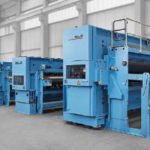German manufacturers of Textile and garment machineries record impressive growth
Orders up 37 percent in real terms/Turnover grows by 14 percent / Poland, Italy and France as strongest export markets
Orders and sales of the German manufacturers of Textile Care, Fabric and Leather Technologies are still on a growth course: in the period from October 2021 to September 2022, incoming orders increased by 37 percent in real terms and sales are also positive for the technology manufacturers with a growth of 14 percent compared to the previous year. Only exports in the sewing and garment technology sector weakened slightly in the first eight months of 2022 and fell by 5 percent to 265 million euros.
Poland still the most important export market
The most important export market from a German perspective was Poland, followed by Italy and France. German suppliers of shoe and leather technology were again able to increase their exports by 8 percent to 34 million euros in the period from January to August 2022. Here, the main customer countries were the USA, Mexico and Italy. Exports of German laundry and dry-cleaning technology also increased in the first eight months of 2022 by 17 percent to 272 million euros. As last year, the most important export markets were Poland, the USA and Turkey.
“The mood among manufacturers of Textile Care, Fabric and Leather Technologies is largely positive,” said Elgar Straub, Managing Director of VDMA Textile Care, Fabric and Leather Technologies at the trade association’s industry meeting in Brussels. “Despite the enormous increase in energy costs, the still existing problems in the supply chains and the still unforeseeable consequences of the war, the industry representatives report well-filled order books.”
Industry meeting in Brussels
The VDMA Textile Care, Fabric and Leather Technologies industry meeting was held in Brussels for the first time. The focus was on topics such as the EU’s Green Deal initiative and its consequences for SMEs, as well as current EU trade policy issues. In particular, the relationship with the United States was discussed and the participants had the opportunity to exchange views with representatives of the European Commission.
Mechanical and plant engineering: engineers sought as never before
The number of vacancies for engineers in the mechanical engineering sector has reached a new high and demand will continue to grow. Currently, two out of three companies have engineering vacancies to fill.
Mechanical and plant engineering is Germany’s most important employer of engineers – but there could be many more. That’s because the number of vacancies for engineers has reached a new high, and demand is set to grow even further. Currently, two out of three companies have vacancies for engineers to fill – significantly more than in the past. This is shown by the new VDMA engineering survey, which is conducted every three years.
“Despite many economic uncertainties, for example in connection with energy prices, the demand for female engineers is immense. As the largest industrial employer, mechanical and plant engineering is and will remain a secure future industry for the next generation of engineers, and it needs the know-how of these talented individuals,” VDMA Vice President Henrik Schunk commented on the results.
Mechanical engineering studies in particular demand
According to the study, the majority of companies expect the number of employed engineers in the companies to increase even further within the next five years – despite the current economic slowdown. Almost 60 percent of the companies surveyed expect employment to continue to rise until 2027.
Engineers with a mechanical engineering degree continue to be in greatest demand. However, the demand for engineers with a degree in electrical engineering, mechatronics or computer science has also grown strongly. “Young people currently have the best career prospects in mechanical and plant engineering,” emphasizes Hartmut Rauen, Deputy Executive Director of the VDMA. “Our industry is the most important engineering employer. It offers young people an attractive working environment in which they can help develop and shape future technologies. Here, for example, they work on technical solutions for climate and environmental protection, medical technology or for feeding the world’s growing population.”
Hartmut Rauen, Deputy Executive Director of VDMA:
“Young people currently have excellent career prospects in mechanical and plant engineering.“
Labor shortages and a lack of qualifications are major hurdles
The proportion of engineers employed in mechanical and plant engineering has been rising for years. It is true that the Corona crisis in 2020 briefly caused engineering employment in mechanical engineering to decline. However, it has since returned to close to the record level seen in 2019. Currently, more than 180,000 engineers are employed in the German mechanical engineering sector, or just under 16 percent of the workforce (in companies with at least 20 employees).
The increase in engineering employment is currently limited by labor shortages. The majority of companies can no longer fill their vacancies promptly. In addition, one in four companies say they cannot find the people with the qualifications they need.
Hiring needs for R&D particularly high
A majority of the companies surveyed also expect a shortage of engineering staff in the coming years. This applies to all key areas of the company, especially research and development (R&D) and design. Together, more than half of the engineers now work in these two areas. This is typical of the mechanical and plant engineering sector with its high innovative strength.
The need for recruitment over the next three years is also greatest in both areas of the company. 76 percent of the companies want to hire engineers in design during this period. 71 percent say the same for research and development. Here, only 16 percent of companies do not expect a shortage of engineers. The shortage of skilled workers in these areas of innovation thus threatens to become a brake on innovation and growth.
The number of vacant skilled worker positions is also on the rise
In addition to vacancies for engineers, almost 90 percent of companies currently have vacancies for skilled workers and almost 60 percent for technicians and/or master craftsmen – both significantly more than in the last engineering survey in 2019.
“As the largest employer of STEM occupations, our industry is just the place for people who want to innovate and create. Career opportunities have never been better for masters, master craftsmen, skilled men and women. In addition, two-thirds of CEOs in mechanical engineering are engineers,” explains VDMA Vice President Schunk.



